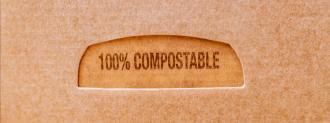With growing public awareness and concern about the environment, companies are making carbon-neutral pledges and striving to reduce their waste.
But it isn’t always easy to know which disposable packaging is the most “green” — or even the least red.
A new scorecard can be the judge. The Understanding Packaging (UP) Scorecard is giving businesses a guide on sustainable disposable packaging choices.
Why this matters: The Environmental Protection Agency estimates that 30% of total U.S. waste is packaging materials — the largest end-use market sector.
Extravagant packaging has a bad rep for being frivolous and paying a heavy price on the environment and human health. But some disposable packaging has benefits like extending the shelf life for food or reducing weight in transportation.
Because there are few packaging standards to serve as guideposts, claims like recyclable, biodegradable, compostable, non-toxic, and low-carbon make decision-making confusing and muddled. And these labels can have competing benefits. For example, products that have a low-carbon footprint might not be recyclable and vice versa.
The scorecard aims to clear all that up — helping businesses weigh the benefits with the hazards.
What the scorecard can do: The scorecard can help a company select their packaging from the array of choices on the market, taking into account specific health and environmental factors. It uses a standardized assessment to evaluate the effects a product has on the environment from production through disposal.
Extravagant packaging has a bad rep for being frivolous and paying a heavy price on the environment. But some disposable packaging has benefits.
The card will provide a score for chemicals of concern, climate sustainability, water use, sustainable sourcing, and recoverability, according to the website. “Climate sustainability” could account for a product’s carbon footprint during transportation or production. And “chemicals of concern” could consider forever chemicals, which last in the environment for thousands of years, or chemicals that are harmful to human health.
According to an Environmental Defense Fund statement, users can customize the details to suit a company’s goals by prioritizing factors such as percentage of recycled content, use of sustainability certifications, and if the product contains chemicals on the Food Contact Chemicals of Concern List.
The scorecard aims to clear all that up — helping businesses weigh the benefits with the hazards.
The UP Scorecard was launched by leaders from food service corporations and environmental NGOs, including the Environmental Defense Fund. It is a web-based tool, currently, in beta version, that is free for companies to use to help them make sustainable choices.
Similar online scoring systems exist for other industries. A popular one — the Environmental Working Group’s Skin Deep Database — is a widely used website and app that gives a toxicity score for beauty and household products. It also explains what the risks are and why the product earned that score.
Scorecard in action: I gave the scorecard a try and compared beverage containers of three varieties: plastic, aluminum, and glass.
Glass ranked best for chemicals of concern but the worst for climate sustainability. Surprisingly plastic also ranked comparably well for climate sustainability — possibly because aluminum and plastic are lightweight, whereas glass is heavy and bulky and has a larger carbon footprint.
The pandemic sparked a surge in social awareness around trash, and consumer preference is shifting toward reduced or reusable packaging and the circular economy. Maybe consumer purchasing power and the UT scorecard will pressure disposable packaging companies to create more sustainable options.
We’d love to hear from you! If you have a comment about this article or if you have a tip for a future Freethink story, please email us at [email protected].






